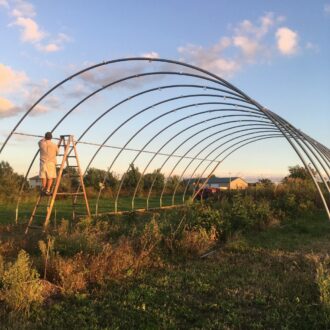Imagine sitting down for lunch and receiving an update from a local farm that fresh figs are available for pick up.
Tim and Beth Malinich run a small niche fruit farm in Nova, Ohio where they grow and direct market fruit berrries, currants, pears, peaches, and figs. Tim is a retired extension educator who worked with fruit and vegetable growers with Ohio State University Extension in Erie County for many years. Beth is a veterinarian. In 2008, they bought a former hay farm and converted about 6 acres into niche fruit production. Starting with berries, they slowly expanded their offerings, and in 2018 decided they wanted to try growing figs on their farm in hardiness zone 6a.
"Figs are a niche crop with a definite market to a smaller number of buyers," said Tim Malinich. "It makes a nice addition to the market, pick-your-own or otherwise."
In 2018, they applied and received a $7,494 NCR-SARE Farmer Rancher grant to plant four varieties of figs using three types of overwintering methods: high tunnels, low tunnels, and no protection. They continued that figs could, in fact, be overwintered successfully with protection in Ohio, and they continue to grow and sell figs on their farm.
Fig Findings
- The high tunnel plants were the most successful, emerging in late April and producing new canes. All their fig plants in the open field died in the first winter. The low tunnel plants survived the winter but emerged too late to provide a decent crop.
- The Olympian and Chicago fig varieties have been their best performers—Olympian figs are larger, and Chicago Hardy figs are more prolific and sweeter.
- They learned that fig plants prefer to be hot and wet—"The high tunnel is a sauna," said Malinich, "and the figs love it."
- They initially questioned whether a 12’ high tunnel made sense, but the fig plants reached 10’ quickly. They had to prune the tops to protect the high tunnel plastic from the branches.
- Since the time of the study, they have increased the mulch they use to match the mature plants' size better.
- Beware of pests. Mice, rabbits, and yellow jackets all love figs.
The Malinichs continue to grow figs in a high tunnel environment. Although they have increased their prices, they have more consumer demand for the figs. Tim Malinich questions the commercial viability of fig production in high tunnels in Ohio. He says regions with a warmer climate would find it easier to produce a viable fig crop and make it profitable. Still, they intend to continue growing and selling figs at their farm.
"When the research project was finished, and we determined that under the research parameters, figs were not profitable in our area, I asked my wife what she might want to plant in the high tunnel in place of figs," said Minich. "Without hesitation, she said she wanted to keep the figs and improve the planting—she likes marketing the unusual crops we have. Though not quite profitable for our market, the plants have been more productive each year of maturity. Continuing to monitor the high tunnel production for several more years will reveal the extent of the plants' maturity, root system, and pruning practices on the total marketable harvest. Increased production will open new markets and a possible increase in price."
View Related SARE Grant:
- Figs as a Niche Crop in Northern Ohio (fnc18-1135)
